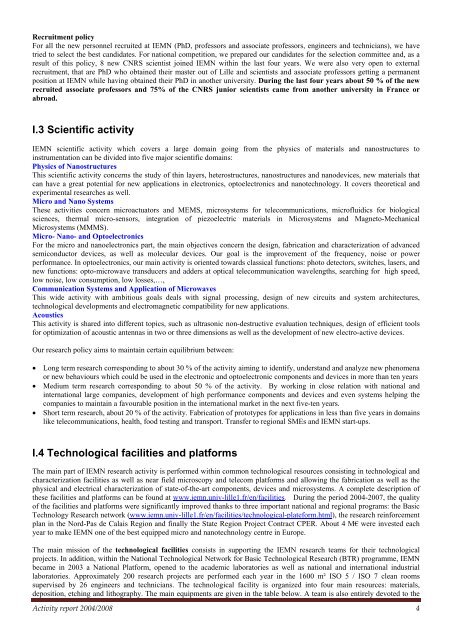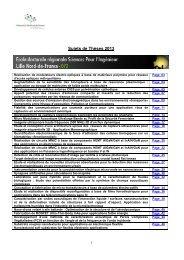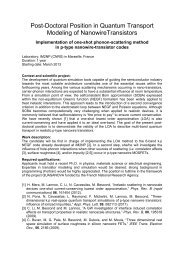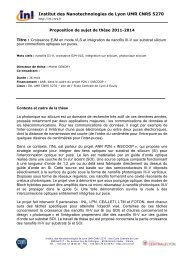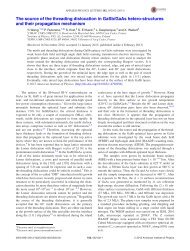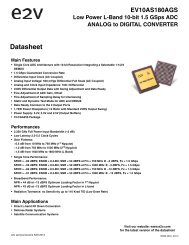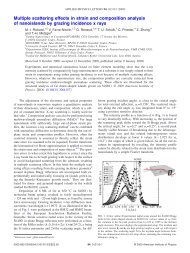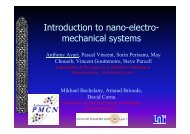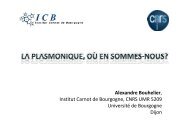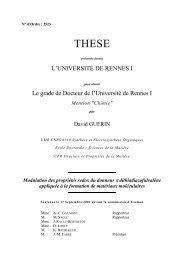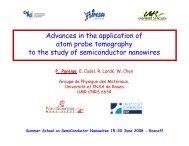Activity Report 2004-2008 (3,5 MB â 1st - IEMN
Activity Report 2004-2008 (3,5 MB â 1st - IEMN
Activity Report 2004-2008 (3,5 MB â 1st - IEMN
- No tags were found...
Create successful ePaper yourself
Turn your PDF publications into a flip-book with our unique Google optimized e-Paper software.
Recruitment policyFor all the new personnel recruited at <strong>IEMN</strong> (PhD, professors and associate professors, engineers and technicians), we havetried to select the best candidates. For national competition, we prepared our candidates for the selection committee and, as aresult of this policy, 8 new CNRS scientist joined <strong>IEMN</strong> within the last four years. We were also very open to externalrecruitment, that are PhD who obtained their master out of Lille and scientists and associate professors getting a permanentposition at <strong>IEMN</strong> while having obtained their PhD in another university. During the last four years about 50 % of the newrecruited associate professors and 75% of the CNRS junior scientists came from another university in France orabroad.I.3 Scientific activity<strong>IEMN</strong> scientific activity which covers a large domain going from the physics of materials and nanostructures toinstrumentation can be divided into five major scientific domains:Physics of NanostructuresThis scientific activity concerns the study of thin layers, heterostructures, nanostructures and nanodevices, new materials thatcan have a great potential for new applications in electronics, optoelectronics and nanotechnology. It covers theoretical andexperimental researches as well.Micro and Nano SystemsThese activities concern microactuators and MEMS, microsystems for telecommunications, microfluidics for biologicalsciences, thermal micro-sensors, integration of piezoelectric materials in Microsystems and Magneto-MechanicalMicrosystems (MMMS).Micro- Nano- and OptoelectronicsFor the micro and nanoelectronics part, the main objectives concern the design, fabrication and characterization of advancedsemiconductor devices, as well as molecular devices. Our goal is the improvement of the frequency, noise or powerperformance. In optoelectronics, our main activity is oriented towards classical functions: photo detectors, switches, lasers, andnew functions: opto-microwave transducers and adders at optical telecommunication wavelengths, searching for high speed,low noise, low consumption, low losses,…,Communication Systems and Application of MicrowavesThis wide activity with ambitious goals deals with signal processing, design of new circuits and system architectures,technological developments and electromagnetic compatibility for new applications.AcousticsThis activity is shared into different topics, such as ultrasonic non-destructive evaluation techniques, design of efficient toolsfor optimization of acoustic antennas in two or three dimensions as well as the development of new electro-active devices.Our research policy aims to maintain certain equilibrium between:• Long term research corresponding to about 30 % of the activity aiming to identify, understand and analyze new phenomenaor new behaviours which could be used in the electronic and optoelectronic components and devices in more than ten years• Medium term research corresponding to about 50 % of the activity. By working in close relation with national andinternational large companies, development of high performance components and devices and even systems helping thecompanies to maintain a favourable position in the international market in the next five-ten years.• Short term research, about 20 % of the activity. Fabrication of prototypes for applications in less than five years in domainslike telecommunications, health, food testing and transport. Transfer to regional SMEs and <strong>IEMN</strong> start-ups.I.4 Technological facilities and platformsThe main part of <strong>IEMN</strong> research activity is performed within common technological resources consisting in technological andcharacterization facilities as well as near field microscopy and telecom platforms and allowing the fabrication as well as thephysical and electrical characterization of state-of-the-art components, devices and microsystems. A complete description ofthese facilities and platforms can be found at www.iemn.univ-lille1.fr/en/facilities. During the period <strong>2004</strong>-2007, the qualityof the facilities and platforms were significantly improved thanks to three important national and regional programs: the BasicTechnology Research network (www.iemn.univ-lille1.fr/en/facilities/technological-plateform.html), the research reinforcementplan in the Nord-Pas de Calais Region and finally the State Region Project Contract CPER. About 4 M€ were invested eachyear to make <strong>IEMN</strong> one of the best equipped micro and nanotechnology centre in Europe.The main mission of the technological facilities consists in supporting the <strong>IEMN</strong> research teams for their technologicalprojects. In addition, within the National Technological Network for Basic Technological Research (BTR) programme, <strong>IEMN</strong>became in 2003 a National Platform, opened to the academic laboratories as well as national and international industriallaboratories. Approximately 200 research projects are performed each year in the 1600 m² ISO 5 / ISO 7 clean roomssupervised by 26 engineers and technicians. The technological facility is organized into four main resources: materials,deposition, etching and lithography. The main equipments are given in the table below. A team is also entirely devoted to the<strong>Activity</strong> report <strong>2004</strong>/<strong>2008</strong> 4


